 Susie’s at work again. I’m therefore taking the opportunity to dig out Madhur jaffrey’s Indian Cookery and cook an Indian dinner again, while she battles through the crowds of grown men running around London dressed as rhinos, bananas and deep-sea divers to get home. Sometimes I don’t get her determination to drive to work in King’s Cross when she has a Sunday shift. She points out that the trains run up into Victoria less frequently than the rest of the week; but surely that’s just a matter of checking the timetable online? Hey ho, it’s her business; all I’m saying is, I wouldn’t fancy driving across London twice on the day of the London Marathon.
Susie’s at work again. I’m therefore taking the opportunity to dig out Madhur jaffrey’s Indian Cookery and cook an Indian dinner again, while she battles through the crowds of grown men running around London dressed as rhinos, bananas and deep-sea divers to get home. Sometimes I don’t get her determination to drive to work in King’s Cross when she has a Sunday shift. She points out that the trains run up into Victoria less frequently than the rest of the week; but surely that’s just a matter of checking the timetable online? Hey ho, it’s her business; all I’m saying is, I wouldn’t fancy driving across London twice on the day of the London Marathon.
I’m doing Madhur Jaffrey’s Kashmiri red lamb stew. It’s got no onions in it, which will please Susie. Interestingly, there’s also no cumin, coriander or turmeric – this hinges around cloves, cinnamon, paprika, cayenne, dried ginger and ground fennel seeds, all of which is bound together with most of a pint of natural yoghurt. (Not to self: what is asafetida and where can I buy it? Wikipedia lists devil’s dung, stinking gum among its nicknames …)
While I was stirring the meat and reducing the yoghurt, I was thinking about a fantastic, life-affirming trip I took to a school in Northolt on Friday morning. I was invited along by Michael Coaker (formerly Executuve chef at the Intercontinental, Park Lane and now a senior lecturer at Thames Valley University) to watch him deliver a Chefs Adopt a School session to some teens with learning difficulties. The charitable project was set up by a cheffing organisation called the Academy of Culinary Arts to introduce kids to the pleasures of eating real, nutritious food. Chefs including the likes of Brian Turner and the Roux family teach kids basic lessons about the food we eat and the sensations they experience when they taste (bitter, sweet …) before teaching them a simple recipe to try themselves.
In Northolt, the kids were spellbound by Michael’s lesson from the second they arrived in the classroom. He had them smelling Coriander, basil and parsley, and forking the flesh from pomegranetes, before showing them how to make tomato, mozzarella and pesto puff pastry tarts and cheese straws (above). And then they were off: flour was sprinkled, pastry rolled, shapes cut and cheese and tomato sliced. I guess what the kids were doing was the same as what I’m doing with this blog: rolling their sleeves up, having some fun, becoming more comfortable around ingredients and learning along the way. If the challenge of twisting raw pastry into spirals had the kids in hysterics, the moment when their tarts came out of the oven and were plated up had them beaming like Cheshire cats. The whole session was fantastic. I wish I could add some photos I took of the class, but I haven’t got clearance from the teacher yet.
When I got home, I spent a few minutes leafing through a book of recipes by Alain Ducasse. I must admit, his endless lists of foie gras, truffle and caviar left me a little cold after having seen how much pleasure had been achieved with a few tomatoes, a ball of mozzarella and a wodge of puff pastry.
[I wrote this post listening to the Sensational Alex Harvey Band and watching the helipcopters over the London Marathon]
Filed under: About me, Recipes to try | Tagged: Academy of Culinary Arts, Alain Ducasse, Chefs Adopt a School, Indian cookery, Indian food, Kashmir, lamb, London Marathon, Madhur Jaffrey | Leave a comment »
 One of my fondest childhood food memories is of eating freshly baked Welsh cakes straight from the cooling rack, after my mum had made up a fresh batch. Her Welsh cakes are always delicious, but especially so, when still warm from the pan. Today, mum taught me how to make them myself – a major rite of passage, in Lewis family terms.
One of my fondest childhood food memories is of eating freshly baked Welsh cakes straight from the cooling rack, after my mum had made up a fresh batch. Her Welsh cakes are always delicious, but especially so, when still warm from the pan. Today, mum taught me how to make them myself – a major rite of passage, in Lewis family terms.











 Sunday’s supper was
Sunday’s supper was 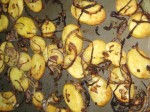 Delia’s How to Cheat at Cooking
Delia’s How to Cheat at Cooking Zafferano, Alain Ducasse, ras el hanout … Scanning some of my recent posts, I’m struck by just what a faux gourmand I sound. My diet hasn’t always revolved around Michelin stars, champagne and black truffle – and still doesn’t. Back in the day, I liked nothing better than to mix and match a couple of tins and whack their combined contents on a mountain of rice.
Zafferano, Alain Ducasse, ras el hanout … Scanning some of my recent posts, I’m struck by just what a faux gourmand I sound. My diet hasn’t always revolved around Michelin stars, champagne and black truffle – and still doesn’t. Back in the day, I liked nothing better than to mix and match a couple of tins and whack their combined contents on a mountain of rice. Very bland, this recipe. I had a couple of lamb shanks in the fridge this afternoon and couldn’t find my favourite tajine recipe, so I opted for good old
Very bland, this recipe. I had a couple of lamb shanks in the fridge this afternoon and couldn’t find my favourite tajine recipe, so I opted for good old  On the upside, the couscous was zingy: I mixed 7 ounces of it with 250ml of hot water, then stirred in a glug of olive oil, a generous handful of coriander, salt, pepper and the juice of a whole lemon.
On the upside, the couscous was zingy: I mixed 7 ounces of it with 250ml of hot water, then stirred in a glug of olive oil, a generous handful of coriander, salt, pepper and the juice of a whole lemon.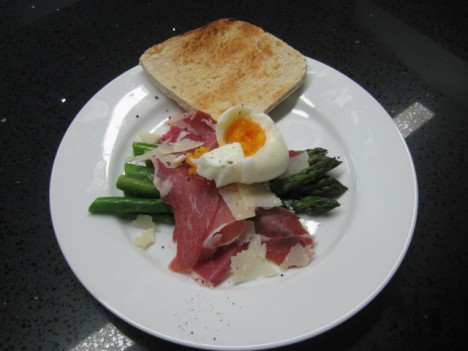 Last night, boutique contract caterers
Last night, boutique contract caterers 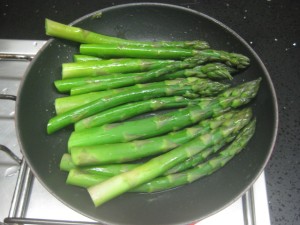 Tonight, we decided to throw together an asparagus, parma ham, soft boiled egg and parmesan salad, with a hunk of soda farl. Cliched as it may sound, I realised I didn’t know how to boil an egg, at least not a perfectly gooey, soft boiled egg that would ooze over the asparagus like sunshine at dawn. Queue St Delia. Her
Tonight, we decided to throw together an asparagus, parma ham, soft boiled egg and parmesan salad, with a hunk of soda farl. Cliched as it may sound, I realised I didn’t know how to boil an egg, at least not a perfectly gooey, soft boiled egg that would ooze over the asparagus like sunshine at dawn. Queue St Delia. Her  While I tried in vain to make a hard-boiled egg look runny for the camera, Susie grabbed our copy of
While I tried in vain to make a hard-boiled egg look runny for the camera, Susie grabbed our copy of  Susie’s at work again. I’m therefore taking the opportunity to dig out
Susie’s at work again. I’m therefore taking the opportunity to dig out 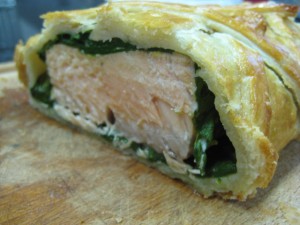 The banana bread turned out to be just a prelude. Next came a salmon en croute to use up the pastry I had left over from my recent tarte tatin. Here’s a thing: if I wanted to make salmon en croute, I’d have half of our cook books out on the worktop, and I’d be agonising over the hair’s-breadth differences between the various recipes I came across. (On the other hand, I guess that’s why I started this blog in the first place, so I shouldn’t beat myself up.)
The banana bread turned out to be just a prelude. Next came a salmon en croute to use up the pastry I had left over from my recent tarte tatin. Here’s a thing: if I wanted to make salmon en croute, I’d have half of our cook books out on the worktop, and I’d be agonising over the hair’s-breadth differences between the various recipes I came across. (On the other hand, I guess that’s why I started this blog in the first place, so I shouldn’t beat myself up.) 
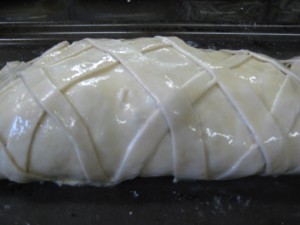

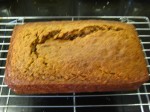 She shoots, she scores. Susie has politely stayed out of the kitchen for the past few weeks while I’ve bumbled around creating a few dishes to get this blog on the road. This afernoon, she decided it was time for the amateurs to step aside and let a professional through to the oven. Like the goal-poaching striker who drifts in and out of the match but always materialises on the far post when the cross comes in, she appeared from nowhere in the kitchen this afternoon and displayed all the talents of a class finisher.
She shoots, she scores. Susie has politely stayed out of the kitchen for the past few weeks while I’ve bumbled around creating a few dishes to get this blog on the road. This afernoon, she decided it was time for the amateurs to step aside and let a professional through to the oven. Like the goal-poaching striker who drifts in and out of the match but always materialises on the far post when the cross comes in, she appeared from nowhere in the kitchen this afternoon and displayed all the talents of a class finisher.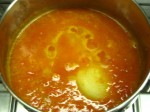 Here’s the
Here’s the 